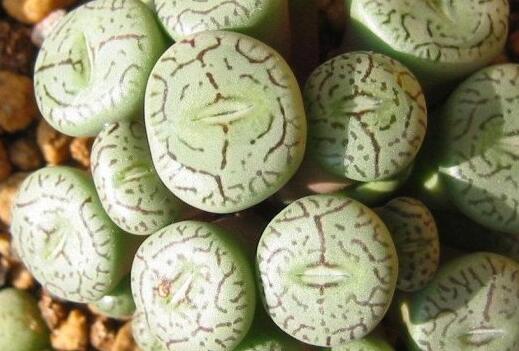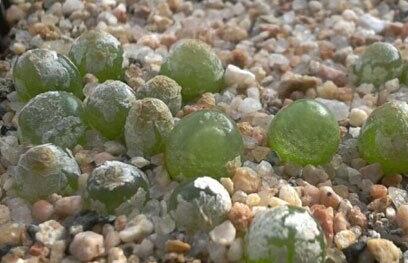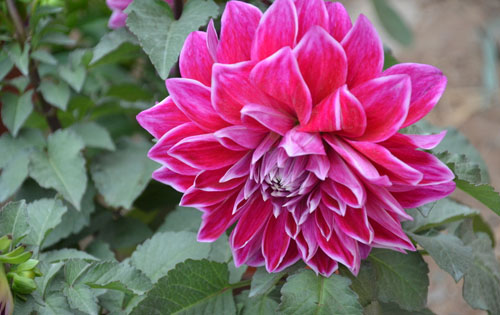The cultivation and maintenance method of meat cone flower teaches you how to raise it best.
Succulent cone is the general name of apricot family and succulent plant, its variety is various, and its shape is different, the common characteristic is that the plant is small, there are a pair of very succulent opposite leaves directly above the root, the leaf shape is spherical and inverted conical, its lower part is United and integrated, there are cracks of different depth at the top, dark green, emerald green, yellow-green and other colors, and there are patterns or spots on the leaves of some varieties. Today, the editor brings you the methods of breeding and conservation of meat cones. Let's take a look at the details.

The culture and maintenance methods of meat cone flower:
1. Growth
The growth of fleshy cones begins in the summer, and there are 1 or 2 times of water supply this season, and the new ball will break through the gray-white old skin and begin to grow vigorously. At this time, sharing the ball has become the greatest fun. It is the embodiment of good management in the previous year, poor growth or old plants are more difficult to divide the ball. The ball increasing rate depends on the variety and cultivation skills. Do not use the ordinary multiplication method to count, the increase of the ball is carried out by the so-called mouse formula, more than 30 balls after 5 years, 100 balls after 7 years, and more than 1000 balls 10 years later, its value will increase with the increase of the number of heads. The meat cone flower looks very beautiful at this time, looking at the colorful flowers, the special growth process, the group beauty after increasing the ball, especially the proliferation fun of the "mouse formula" makes it a gem-grade plant. The dormancy time of the growth of fleshy cones is also different. For those with only a few weeks of growth, taking into account their nearly 40-week dormancy, these varieties are cultivated by watering them from time to time to keep them semi-dormant. In addition to the relationship between cold and summer, their production cycle is mainly composed of dry-wet relationship, which may be 200 days or 150 days. Do not consider only the human cycle, but the cycle of the native plant itself.
2. Watering
The plant is dormant in high temperature in summer and can be maintained in a cool and ventilated place. Only when the soil is too dry can a small amount of water be irrigated or even completely cut off to prevent decay. When it is cool in autumn, the plant begins to grow and bloom beautiful flowers, which can be moved to a place with bright light and properly watered. Plants with good growth can be fertilized with mature thin liquid fertilizer once a month, and pay attention to timing for artificial pollination when flowering.
Sufficient sunshine is required in winter. If you can keep it above 12 degrees Celsius at night and above 20 degrees Celsius during the day, you can water it normally and apply some thin fertilizer on a sunny morning as appropriate. If the temperature is low, it is necessary to control watering, stop fertilizing and make it dormant.
With the growth of the plant in spring, the fruit ripens gradually, so attention should be paid to harvest. In late spring and early summer, the old leaves of most varieties gradually thinned, and two pairs of new leaves gradually formed in the old leaves.
In cultivation, rain forests and stagnant water should be avoided at any time, and the growing period should be exposed to more sunlight, otherwise the plant will grow too long and cannot blossom. Turn the basin every 1 to 2 years, the basin soil can be made of rotten leaf soil plus 1 / 2 coarse sand or vermiculite, and the particles should be coarse and not too fine.
The complete wrapping of the old skin during the dormant period cleverly prevents the moisture evaporation of the new ball, and being drenched in the rain or too high humidity in the greenhouse during the rainy season may lead to early peeling. If the water is still cut off for that kind of plant, the new ball softens and shrinks because the evaporated water can not be replenished, so it is necessary to water regularly in this special case.
Watering method, the ball can keep moist is very ideal (for the old peeling period plants should pay attention to the water supply is not easy to dry), because of time, labor from above watering should be selected in sunny days, when there are conditions for ventilation, it should be noted that one plant or too many plants do not apply this method. If the light is 10, then the one given to the meat cone is 8. Considering the shape of the meat cone, the diversity of size should also be treated separately on the issue of light. It is common sense that large species are stronger and smaller ones are weaker.
3. Lighting
Consider in terms of spherical color, or further consider the relationship between solar radiation and flower color: yellow and white reflect the most light, and the varieties with such colors must grow in quite strong light in their native place, followed by brown flowers, peach flowers, safflower species, etc., followed by purple flowers, according to their respective habits to take appropriate shade, stone flowers to white flowers, yellow flowers are common The large species of yellow flowers in the meat cone can be arranged according to the lighting requirements of raw stone flowers. Varieties of colors that are difficult to reflect light should be properly shaded.
Lack of sunshine during the growing period will degenerate the characteristics of plant varieties and change their appearance and color. It is also the cause of weakening and corruption.
Culture and maintenance methods of Meat Cone Flower
The growth and dormancy of the fleshy cones are the easiest to judge among the female immortals. There is no doubt that the dormant flowers will turn gray and begin to shrink. The dormant period is generally from late May to late August for about 3 months. According to different places, there are some differences in varieties. Next, let's take a look at the cultivation and maintenance methods of meat cone flowers together with the editor of Boqi Network.
Meat cone flower
I. growth
The growth of fleshy cones begins in the summer, and there are 1 or 2 times of water supply this season, and the new ball will break through the gray-white old skin and begin to grow vigorously. At this time, sharing the ball has become the greatest fun. It is the embodiment of good management in the previous year, poor growth or old plants are more difficult to divide the ball. The ball increasing rate depends on the variety and cultivation skills. Do not use the ordinary multiplication method to count, the increase of the ball is carried out by the so-called mouse formula, more than 30 balls after 5 years, 100 balls after 7 years, and more than 1000 balls 10 years later, its value will increase with the increase of the number of heads. The meat cone flower looks very beautiful at this time, looking at the colorful flowers, the special growth process, the group beauty after increasing the ball, especially the multiplication fun of the "mouse formula" makes it a gem plant. The dormancy time of the growth of fleshy cones is also different. For those with only a few weeks of growth, taking into account their nearly 40-week dormancy, these varieties are cultivated by watering them from time to time to keep them semi-dormant. In addition to the relationship between cold and summer, their production cycle is mainly composed of dry-wet relationship, which may be 200 days or 150 days. Do not consider only the human cycle, but the cycle of the native plant itself.
Second, watering
The plant is dormant in high temperature in summer and can be maintained in a cool and ventilated place. Only when the soil is too dry can a small amount of water be irrigated or even completely cut off to prevent decay. When it is cool in autumn, the plant begins to grow and bloom beautiful flowers, which can be moved to a place with bright light and properly watered. Plants with good growth can be fertilized with mature thin liquid fertilizer once a month, and pay attention to timing for artificial pollination when flowering.
Sufficient sunshine is required in winter. If you can keep it above 12 degrees Celsius at night and above 20 degrees Celsius during the day, you can water it normally and apply some thin fertilizer on a sunny morning as appropriate. If the temperature is low, it is necessary to control watering, stop fertilizing and make it dormant.
With the growth of the plant in spring, the fruit ripens gradually, so attention should be paid to harvest. In late spring and early summer, the old leaves of most varieties gradually thinned, and two pairs of new leaves gradually formed in the old leaves.
Culture and maintenance methods of Meat Cone Flower
Succulent cone is the general name of apricot family and succulent plant, its variety is various, and its shape is different. The common characteristic is that the plant is small, and there are a pair of very fleshy opposite leaves directly above the root. The leaf shape is spherical and inverted conical, and its lower part is United and integrated. There are cracks of different shades at the top, dark green, emerald green, yellow-green and other colors, and some varieties have patterns or spots on their leaves.
The growth and dormancy of the fleshy cones are also the easiest to judge among the female immortals. There is no doubt that the dormant cones will turn gray and begin to shrink. The dormant period is generally about 3 months from late May to late August. According to different places, there are some differences in varieties.
Second, growth
The growth of fleshy cones begins in the summer, and there are 1 or 2 times of water supply this season, and the new ball will break through the gray-white old skin and begin to grow vigorously. At this time, sharing the ball has become the greatest fun. It is the embodiment of good management in the previous year, poor growth or old plants are more difficult to divide the ball. The ball increasing rate depends on the variety and cultivation skills. Do not use the ordinary multiplication method to count, the increase of the ball is carried out by the so-called mouse formula, more than 30 balls after 5 years, 100 balls after 7 years, and more than 1000 balls 10 years later, its value will increase with the increase of the number of heads. The meat cone flower looks very beautiful at this time, looking at the colorful flowers, the special growth process, the group beauty after increasing the ball, especially the proliferation fun of the "mouse formula" makes it a gem-grade plant. The dormancy time of the growth of fleshy cones is also different. For those with only a few weeks of growth, taking into account their nearly 40-week dormancy, these varieties are cultivated by watering them from time to time to keep them semi-dormant. In addition to the relationship between cold and summer, their production cycle is mainly composed of dry-wet relationship, which may be 200 days or 150 days. Do not consider only the human cycle, but the cycle of the native plant itself.
Second, watering
The plant is dormant in high temperature in summer and can be maintained in a cool and ventilated place. Only when the soil is too dry can a small amount of water be irrigated or even completely cut off to prevent decay. When it is cool in autumn, the plant begins to grow and bloom beautiful flowers, which can be moved to a place with bright light and properly watered. Plants with good growth can be fertilized with mature thin liquid fertilizer once a month, and pay attention to timing for artificial pollination when flowering.
Sufficient sunshine is required in winter. If you can keep it above 12 degrees Celsius at night and above 20 degrees Celsius during the day, you can water it normally and apply some thin fertilizer on a sunny morning as appropriate. If the temperature is low, it is necessary to control watering, stop fertilizing and make it dormant.
With the growth of the plant in spring, the fruit ripens gradually, so attention should be paid to harvest. In late spring and early summer, the old leaves of most varieties gradually thinned, and two pairs of new leaves gradually formed in the old leaves.
Article source: http://www.yuhuagu.com
In cultivation, rain forests and stagnant water should be avoided at any time, and the growing period should be exposed to more sunlight, otherwise the plant will grow too long and cannot blossom. Turn the basin every 1 to 2 years, the basin soil can be made of rotten leaf soil plus 1 / 2 coarse sand or vermiculite, and the particles should be coarse and not too fine.
The complete wrapping of the old skin during the dormant period cleverly prevents the moisture evaporation of the new ball, and being drenched in the rain or too high humidity in the greenhouse during the rainy season may lead to early peeling. If the water is still cut off for that kind of plant, the new ball softens and shrinks because the evaporated water can not be replenished, so it is necessary to water regularly in this special case.
Watering method, the ball can keep moist is very ideal (for the old peeling period plants should pay attention to the water supply is not easy to dry), because of time, labor from above watering should be selected in sunny days, when there are conditions for ventilation, it should be noted that one plant or too many plants do not apply this method. If the light is 10, then the one given to the meat cone is 8. Considering the shape of the meat cone, the diversity of size should also be treated separately on the issue of light. It is common sense that large species are stronger and smaller ones are weaker.
Third, lighting
Consider in terms of spherical color, or further consider the relationship between solar radiation and flower color: yellow and white reflect the most light, and the varieties with such colors must grow in quite strong light in their native place, followed by brown flowers, peach flowers, safflower species, etc., followed by purple flowers, according to their respective habits to take appropriate shade, stone flowers to white flowers, yellow flowers are common The large species of yellow flowers in the meat cone can be arranged according to the lighting requirements of raw stone flowers. Varieties of colors that are difficult to reflect light should be properly shaded.
Lack of sunshine during the growing period will degenerate the characteristics of plant varieties and change their appearance and color. It is also the cause of weakening and corruption.
Article source: http://www.yuhuagu.com
- Prev

Meat cone light bulb how to maintain the best when it blossoms for several years
The meat cone light bulb is a plant of the genus Amygdalaceae. The surface of the plant is bright green and translucent, and it will blossom as long as the environment is right. How long does the meat cone light bulb bloom? the dormant period from May to September is the dormant period of the meat cone flower. After the dormancy period, the flower begins to grow and then blossoms, almost at the end of September and the beginning of October.
- Next

The planting method of dahlia is colorful and lovely.
The shape of the dahlia is similar to that of the peony, which is colorful and lovable. Mexicans regard dahlia as a symbol of generosity and richness, so they respect it as the national flower. Let's take a look at the planting methods of dahlias.
Related
- Fuxing push coffee new agricultural production and marketing class: lack of small-scale processing plants
- Jujube rice field leisure farm deep ploughing Yilan for five years to create a space for organic food and play
- Nongyu Farm-A trial of organic papaya for brave women with advanced technology
- Four points for attention in the prevention and control of diseases and insect pests of edible fungi
- How to add nutrient solution to Edible Fungi
- Is there any good way to control edible fungus mites?
- Open Inoculation Technology of Edible Fungi
- Is there any clever way to use fertilizer for edible fungus in winter?
- What agents are used to kill the pathogens of edible fungi in the mushroom shed?
- Rapid drying of Edible Fungi

